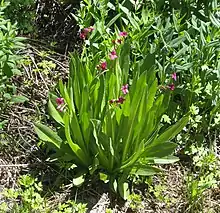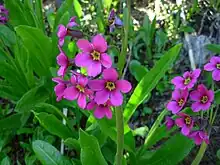Primula parryi
Primula parryi, or Parry's primrose, is a herbaceous perennial native to wet areas from the subalpine zone to alpine tundra in the Rocky Mountains from Montana to Arizona and New Mexico.

whole plant
| Primula parryi | |
|---|---|
 | |
| Scientific classification | |
| Kingdom: | Plantae |
| Clade: | Tracheophytes |
| Clade: | Angiosperms |
| Clade: | Eudicots |
| Clade: | Asterids |
| Order: | Ericales |
| Family: | Primulaceae |
| Genus: | Primula |
| Species: | P. parryi |
| Binomial name | |
| Primula parryi | |
Flowers are magenta with yellow eyes. In the high mountains, they bloom in summer; at lower elevations, in late spring.
The whole plant has a skunklike smell.
Asa Gray named Parry's primrose for Charles Christopher Parry, who discovered it in 1861. Parry had previously named Grays Peak after him.[1]
References
- Houk, Rose (1987). Wildflowers of the American West. San Francisco: Chronicle Books. ISBN 0-87701-424-8.
Wikimedia Commons has media related to Primula parryi.
External links
 Media related to Primula parryi at Wikimedia Commons
Media related to Primula parryi at Wikimedia Commons Data related to Primula parryi at Wikispecies
Data related to Primula parryi at Wikispecies- Southwest Colorado Wildflowers
- Primula parryi in the CalPhotos photo database, University of California, Berkeley
- Native Plant Identification Network, USDA PLANTS Profile
This article is issued from Wikipedia. The text is licensed under Creative Commons - Attribution - Sharealike. Additional terms may apply for the media files.